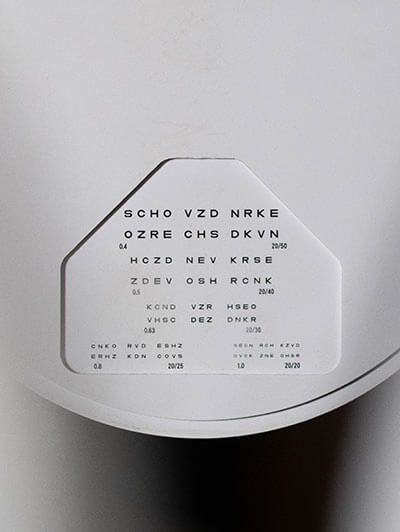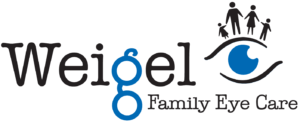
Ortho-K
Many patients with vision problems heartily embrace the idea of enjoying vision correction without having to wear eyeglasses or contact lenses. Not all of these patients, however, are good candidates for refractive surgery. If that describes you, don’t fret — because here at Weigel Family Eye Care, we offer an advanced corneal reshaping technique known as orthokeratology, or Ortho-K. This non-surgical technique can produce changes to the way your cornea refracts light.
To understand the benefits of Ortho-K, let us first consider how the cornea works. The cornea is a transparent, spherical bulge that sits over the lens of your eye. In addition to protecting the inner parts of the eye, the cornea also performs some lens-like tasks of its own. The shape of cornea causes incoming light rays to be refracted, or bent, in such a way that the lens can focus them into a clear, sharp image before they pass on to the retina and optic nerve. Ultimately, the optic nerve transmits the image to your brain.
Some of our patients simply don’t like the idea of any kind of surgery, or they want a reversible procedure. Orthokeratology may be an ideal choice for these individuals. Our doctors will map the shape of your corneas precisely and then fabricate special contact lenses. Unlike standard contacts, you’ll wear these lenses at night. The lenses perform a subtle corneal reshaping as you sleep, meaning that you can take them out the next morning and enjoy perfect or near-perfect vision.
Ortho-K can help you see clearly for one or two days at a time, or possibly even longer. By wearing them regularly at night, you can maintain your clarity of vision for as long as you decide to continue using them. If you decide to use another form of vision correction, simply stop wearing the Ortho-K lenses and your corneas will assume their previous shape once again. Talk to our knowledgeable staff to see whether Ortho-K makes sense for you.
Common Questions about OrthoK/CRT
Here are answers to frequently asked questions:
What is Orthokeratology? What is CRT?
Orthokeratology (OrthoK) uses specially designed rigid contact lenses to temporarily reshape the front of the eye overnight leading to improved vision without the need for glasses or contact lenses while awake. CRT stands for Corneal Refractive Therapy from Paragon Vision Sciences.
How does it work?
The lenses work by temporarily re-shaping the front of the eye overnight. It could be thought of as similar to how dental braces to re-align teeth, but rather re-shape the eye with a contact lens.
I’ve heard some people say that OrthoK can slow down myopic prescription changes? Is this true?
Yes, a scholarly research review article from 2016 by Jeff Walline, OD, PhD reported that OrthoK is one of the three most effective methods of reducing the rate of myopia (nearsightedness) progression in children.
How much does OrthoK cost?
The fitting process for OrthoK (CRT) lenses at Weigel Family Eye Care costs $1375. This includes all of the office visits to make sure that the lenses fit well initially, training to learn how to insert, remove, and care for the lenses, and the first pair of lenses to take home. This is a one time fee. Any routine annual eye examinations are to be paid separately and any further contact lens evaluation fees after the fitting process is completed are also extra and are currently $35 to $45.
What if my child doesn’t like the CRT/OrthoK lenses, does it still cost me $1375?
If after the initial dispensing and follow up visit, a patient decides to not continue wearing CRT/OrthoK lenses, the patient can be refunded $600.
How much do replacement lenses cost?
Currently one new OrthoK lens costs $195.
How long can OrthoK work for me?
OrthoK (CRT) lenses were approved by the FDA for use in the USA in the early 2000s. Some patients in our office have been using them for close to 20 years.
How long do I have to sleep each night with the OrthoK lenses in my eyes?
You should attempt to get 7 or more hours of sleep each night. After wearing the lenses for a month or so, some nights 5 or 6 hours may be sufficient. The goal should be 7-8 hours or more per night.
How young can you be to start with OrthoK lenses?
People as young as 6 or 7 years old could theoretically wear these lenses, but the best time to wear contact lenses are when the patient/parent wants to wear contact lenses and the parent feels the child is responsible enough for contact lens wear.
What is the estimated amount of visits that are required for a successful fit?
Patients fit into OrthoK lenses should expect to have around 5- 6 office visits. If any adjustments have to be made, more visits may be required.
Does the first OrthoK lens work for all patients?
Not always. OrthoK lenses are a specialty type of contact lens and while the first lens may be correct for most patients, there is a chance that modifications will have to be made to the initial lens to find the best fitting lens for the clearest vision.
Does OrthoK work for all prescriptions?
No, some people’s prescriptions are outside the range of what can be accomplished with the OrthoK lenses. The best candidates for good outcomes from the CRT lenses are those patients that have a small to moderate amount of nearsightedness (myopia) of between 0.00 D and -4.00 D and minimal to no astigmatism.
Is OrthoK only for children? Can it work for adults?
No, OrthoK lenses can be used by children and adults. The benefits of OrthoK for adults typically do not include slowing the rate of prescription changes, but anyone with the ideal prescriptions, of any age, should expect to see well with the CRT lens technology.

